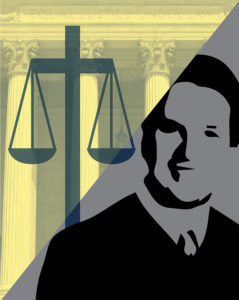CHURCH & STATE | The Kavanaugh Nomination: How Screwed Are We?

The late Chief Justice William H. Rehnquist was no fan of the separation of church and state.
In 1985, when the Supreme Court handed down a decision in a school prayer case called Wallace v. Jaffree, Rehnquist, then an associate justice, decided to cut loose.
“The ‘wall of separation between church and state’ is a metaphor based on bad history, a metaphor which has proved useless as a guide to judging,” Rehnquist wrote in his dissent. “It should be frankly and explicitly abandoned.”
Shocking words indeed. But that was a long time ago. Rehnquist died in 2005. It’s no big deal, right?
Wrong. People’s ideas can live on long beyond their deaths, and Rehnquist’s certainly have. In 1985 his crabbed interpretation of separation of church and state—which essentially seeks to nullify the views of Roger Williams, Thomas Jefferson, and James Madison—was considered to be outside the mainstream, but it inspired a flock of far-right attorneys and judges. And now one of them, Brett Kavanaugh, has been appointed by President Donald Trump to take Anthony M. Kennedy’s seat on the Supreme Court.
Kavanaugh, currently a judge on the US Court of Appeals for the DC Circuit, idolizes Rehnquist and looks to him as a model for how a judge ought to rule. He made this clear during a 2017 speech delivered to the American Enterprise Institute. During that talk, Kavanaugh expressed great admiration for Rehnquist’s church-state views, praising him for “changing the jurisprudence and convincing the court that the wall metaphor was wrong as a matter of law and history.”
On the major church-state issues of the day—the role of religion in public schools, taxpayer aid to religious institutions, and the definition of “religious freedom” to name just three—Kavanaugh has consistently been on the wrong side.
While serving as an attorney in private practice, Kavanaugh wrote a legal brief on behalf of two far-right members of Congress in a 2000 case dealing with school-sponsored prayers before high school football games.
The prayers were clearly coercive. Blared over a loudspeaker, they forced all students to take part in a religious exercise whether they wanted to or not. The Supreme Court recognized this and invalidated the practice. But to Kavanaugh, these prayers should have been permitted on the grounds of tradition.
This is one of the key differences between Kennedy and Kavanaugh: Kennedy understood the dangerous effect religious coercion could have on youngsters attending public schools. Kavanaugh simply dismisses it.
Make no mistake, Kennedy was no hardline separationist. He saw no problem with taxpayer money flowing to sectarian institutions, such as voucher plans that largely benefit religious schools, and he voted to allow for-profit corporations such as Hobby Lobby to deny their employees access to birth control because of the owner’s religious beliefs. But despite his faults, Kennedy was a solid vote on religion-in-schools issues, and we’re losing him. More than sixty years of jurisprudence in this area could be up for reexamination.
A high court right-wing bloc that includes Kavanaugh could also begin undoing Kennedy’s legacy on LGBTQ rights. Guided by Kennedy, the Supreme Court struck down laws criminalizing consensual gay sex among adults, invalidated state laws that singled out LGBTQ people for discrimination, and upheld marriage equality.
All of that now stands in jeopardy, and change could come soon. During Kavanaugh’s confirmation hearings for a seat on the appeals court, he was asked about his agreement with Rehnquist on church-state and other issues. Kavanaugh hid behind a common ploy: he vowed to apply current court precedent, even if he didn’t agree with it. All well and good, but once on the Supreme Court, Kavanaugh won’t be following precedent—he’ll be creating it. (Please don’t make the mistake of assuming that a far-right court will respect precedent. The court, which is pretty conservative right now, has already been happily overturning old decisions.)
A high court attack on church-state separation comes at the worst possible time. The United States is changing. When it comes to religion, our nation is more diverse than ever, and growing numbers of people say they have no religion at all. Only separation of church and state ensures that we will all be able to live together in peace. If Kavanaugh is confirmed, that principle will hang in the balance at the high court.
Church-state separation keeps our public schools secular and focused on teaching, not preaching. It mandates that sectarian projects, such as private religious schools, be funded by the people who believe in them, not the taxpayer at large. The principle prevents religious groups from monopolizing government spaces with signs and symbols that some, but not all, accept.
Separation of church and state also means that no one can be forced to live under someone else’s theology. It means that no American can be harmed or see a loss of rights because of another’s faith.
We’ve seen too much erosion of this principle as it is. We can’t afford to endure even more assaults launched by judges like Kavanaugh. Indeed, our focus should be on rebuilding the wall and replacing bricks that have been removed.
Our nation will need separation of church and state more than ever in the years to come. There’s never a good time to undermine that principle, but this is certainly one of the worst. As 325 million people struggle to live side by side—people who practice a variety of religions and some who practice none—only the separation principle can protect the rights of all.
The alternative is a form of religious supremacy, a society where some people have more rights than others, by dint of their faith. That’s unacceptable. It’s a recipe for conflict, tension, and division. Yet, thanks to Trump’s desire to appease his religious right base, it’s where we may be headed.
